If I ever knew that a real estate development just outside the village of Scotia was once known as “Glen Sanders Manor,” I sure had forgotten that fact. So when I recently ran across some references to “Glen Sanders Manor,” I was definitely confused. But apparently it’s true.
Of course, Scotians are very familiar with Glen Sanders Mansion, and there is a relationship – the lands that became the “manor” were owned by the families that owned the mansion as well.
Beginning in 1922 or so, ads began appearing in the Schenectady Gazette for residential lots in an area being called Glen Sanders Manor. Initially, 124 lots were available, each 60′ x 250′, fronting on “Saratoga state road,” now known as Route 50. The ads touted the proximity to trolley and bus lines, and noted that these lots were within walking distance of Schenectady. Some ads explained that low prices were possible because the property had only ever been held by the Sanders family, and was entering the market for the first time.
“Because the land has passed directly from founders of the Sanders family – 300 years ago – to the SANDERS of today. And YOU ARE THE FIRST BUYER – THEREFORE YOU PAY THE FIRST SALE PRICE.”
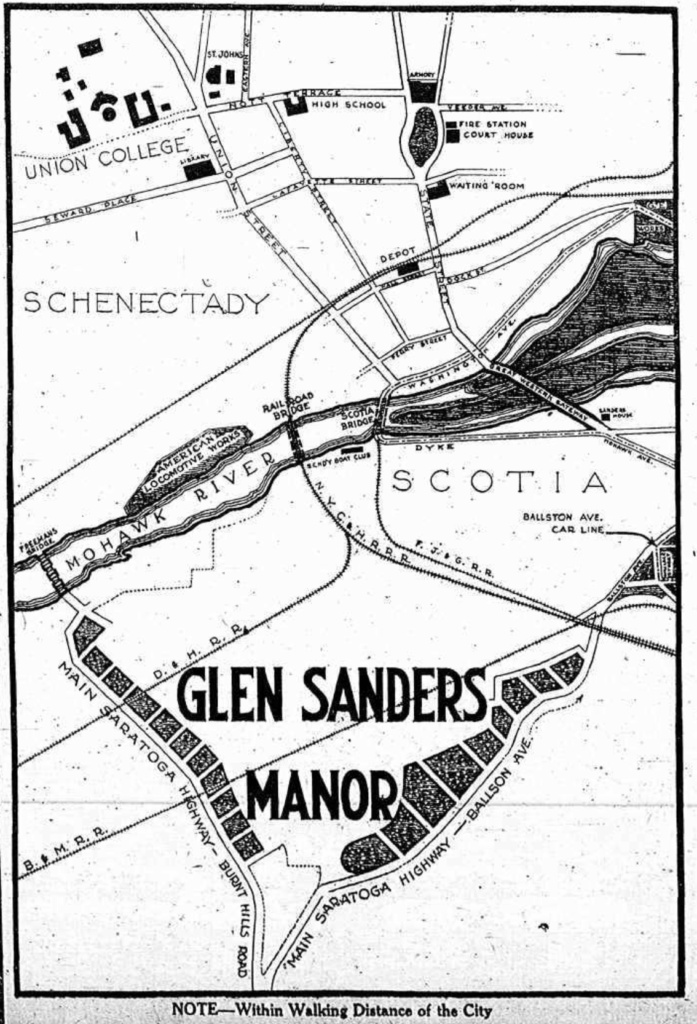
A 1922 classified ad indicated that Glen Sanders Manor “extends from the village line of Scotia, Ballston av. to Thomas Corners, then from there back to Freeman’s Bridge on Burnt Hills rd.” This was along the stretch of Route 50 from the railroad overpass over Ballston Avenue out to Thomas Corners, where Freemans Bridge Road intersects at Worden Road, and then back along Freemans Bridge Road nearly all the way to the bridge.
The lots were being offered by Silberkraus & Son, who had rooms 44-45 in the Parker Building in downtown Schenectady. (At that time, it was the tallest building in the city, and Proctor’s Theatre was not yet located next to it – that was still down by the Erie Canal.) By 1925, Silberkraus had moved to the Lorraine Building. The firm appears to have been made up of Martin Silberkraus and his son, Fred. Martin was an immigrant from Bohemia in the Czech Republic, sometimes listed as the Austria-Hungarian empire. He was born in 1861 (or 1864), immigrated in 1882, and became a very, very busy real estate agent. He lived until 1958; his headstone has him aged 93 or 94.
Ads repeatedly touted that the land was flat, that there were no city taxes, and that two trolley lines and a bus line provided easy access to the city. They also advertised that the lots were restricted – the context appears to mean restricted to residential purposes, but I can’t rule out that they meant the racial restrictions that often applied back then, and which were definitely featured in other real estate ads of the time.
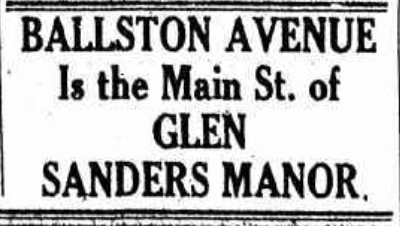
“Walking distance”, they kept saying, and I have to think people had more tolerance for a long walk to work or shopping then than now. One ad claimed “they are only 20 minutes’ walk from locomotive and General Electric works.” Well, maybe they walked a lot faster than I ever did. From the closest point in Glen Sanders Manor to, say, the corner of State Street and Erie Boulevard is just over two miles. Not too far, but still a 40-minute walk. From Thomas Corners, going over Freemans Bridge, that’s just about 3 miles. However, the lots along Freemans Bridge Road were a comparatively short walk to the ALCO plant.
As I’ve written before, the opening of the Great Western Gateway Bridge in 1925 was a huge deal for ease of travel between Scotia and Schenectady, particularly by automobile, which was already dominating society. The narrow iron bridge that connected Washington Avenue in Schenectady with Washington Avenue and The Dyke (Schonowe Avenue) in Scotia also carried trolleys – so while it was a much shorter crossing, it was very congested.

After the Great Western Gateway Bridge opened, ads for Glen Sanders Manor touted that
“The completion of the Great Western Gateway Bridge over the Mohawk has brought the village of Scotia and adjoining sections closer to the business center of Schenectady than at least 50% of the residential areas of your great city and yet real estate values in Scotia are considerably lower than they are in similar locations in resident Schenectady.”
That was in 1926, when 392 “choice residential lots” were being offered at public auction on Decoration Day, May 31, “at 2 p.m. on the premises, under large tent, rain or shine.”
“Directions to reach property – Take Ballston Avenue trolley to Wallace Street, then walk out Ballston Avenue to B.& M. Bridge and you are right at the property. Or, take the F.J. & G. (six-cent fare) to B. & M. Crossing at the property or Telephone 5790 for private auto.” Those were the Boston and Maine Railroad, whose tracks still cross Ballston Avenue, and the Fonda, Johnstown and Gloversville trolley line – an interurban line whose main attraction was its connection to Schenectady from its namesake communities.
The Gazette wrote on June 2 that that had been a very successful sale:
“Something of a record in real estate selling was made Monday at the sale of residential lots at Glen Sanders Manor, Scotia, conducted by William Kennelly, Inc., of New York for Silberkraus and Son of 505 State street, this city. One hundred and twelve lots were sold at public auction in two hours and a half. In spite of the rain a large crowd was on hand for the sale which was admirable conducted under a large tent, the bidding being spirited. This is one of the first one-day auction sales of real estate to be held in this section and the innovation proved to be a popular one. Fred Silberkraus announced yesterday that a selling agent would be on the premises daily to show interested persons the balance of the property.”
That’s a little hard to interpret – at least, if one were to assume that each of those lots would produce a single family home, that never happened. On the Ballston Avenue (east) side, no more than 25 homes sit to this day; a few more were scattered on the approach to Freemans Bridge, where the restrictions against commercial or industrial development seem to have been lifted relatively quickly.
A different 1926 article indicates that the Sanders family, or its estate, were auctioning off the properties, and still held hundreds of acres west of Ballston Avenue. But at the time, The Gazette speculated that it would be very hard to keep such a large property together so close to the city, presumably because there was so much demand in the area.
Though her name doesn’t appear until some transfers in the 1930s, it appears that the lands were being sold off by Mrs. Katherine Sanders Galbraith of Washington, D.C. She was the daughter of Jacob Glen Sanders Jr., and Jane Ten Eyck, of Albany. It seems like the Silberkraus firm acted as an agent for the sales, offering land in classified ads for years, but it’s also clear that son Fred Silberkraus owned some of the properties.
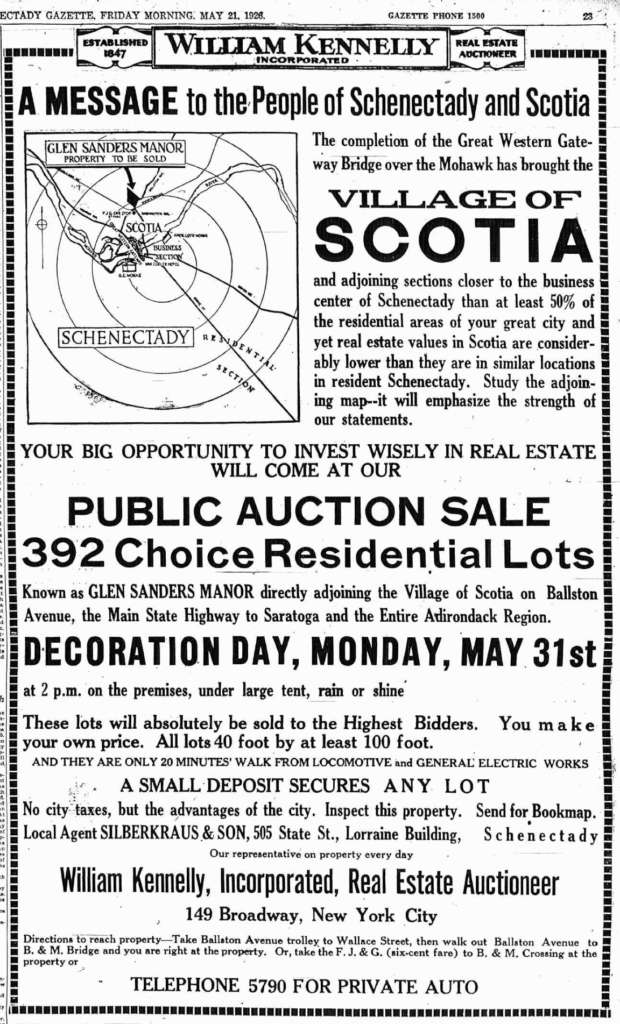
I found several references to Glen Sanders Manor in the newspapers of the 1970s – not in advertising materials, but in tax foreclosure auctions, where various lots marked as “vacant” were occasionally auctioned off. That seems to confirm that any number of the parcels that were sold off initially were never developed into housing in the ensuing decades.
Ida Piotrowski
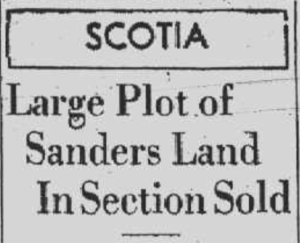
In 1936, well after Glen Sanders Manor was in full swing, the Gazette reported on further breakup of the Sanders family holdings, with the sale of more than 400 acres:
“In one of the largest real estate transactions in the town of Glenville in some time, property which has been in the ownership of members of the Sanders family, pioneer settlers in Scotia, since the earliest development of the area, has been transferred to Walter A. Moore and Ida Piotrowski.
The land, which was at one time part of an immense tract owned by the Sanders family and which extended along the Mohawk river for a considerable distance and back into the hinterland, has now been broken into a number of parcels, the Village of Scotia itself owning several parts. Last year, the Galbraith estate, most recent of the Sanders family, sold a number of lots on Knickerbocker road for building development.
The transaction this year involves more than 400 acres which lie partly in the village and partly in the Town of Glenville. A number of building lots in the village lie on Knickerbocker road while other property which is included in the transaction is situated on the north side of Ballston avenue, 60 acres; east side of Burnt Hills road, 162 acres, and west side of Burnt Hills road, 106 acres. Other lands which have been transferred are on the east side of Washington avenue, 16 acres; and a number of blocks of lots in the Town of Glenville.
According to rumors in the village, it is believed the new owners will utilize the property for a large dairy farm.”
The legal notices associated with that transfer also referred to some of the lots as Glen Sanders Manor.
Ida Piotrowski, according to an obituary on Findagrave.com, was born Ida Maul in Dubrovnik, Poland in 1909 (her obituary said 1907, but multiple census records indicate 1909) and came here with her family when she was four, living on Waters Road in Glenville (as did some of my family). The obituary further said:
“As a young woman, she worked as a piano teacher and at General Electric Company. Later, she owned and operated the Iroquois Golf Course on Hillside Avenue in Schenectady. Finally, she purchased the Glenville property and established Piotrowski Farm, where she had resided with her family since 1936.”
It appears that father Henryk Maul immigrated in 1900, whereas mother Rosa immigrated in 1912 – and it was reported that Ida immigrated in 1913, the same year as her husband Teofil did, but sometimes these records aren’t perfect. The Maul family was present on Waters Road in the 1915 census, but show up much more in Schenectady. In 1930, Ida and husband Theodore were living with her parents (as were other family members) on Avenue A. The census reported that Teofil (name given as Theodore) Piotrowski was 52 when he married 18-year-old Ida about 1927, and he was working as a machinist at “Electrical Co.,” which seems likely to be General Electric. (He died in 1962.) Ida was listed as not working.
I don’t know how Ida or Teofil (whose name appears on some of the legal notices) amassed enough capital to become major landholders, or what their relationship was to Walter Moore, who owned the Iroquois Golf Course on Hillside Avenue at the end of Rosa Road in Niskayuna, and co-owned the Glenville properties with the Piotrowskis. If Ida was an owner of the golf course, which shut down before World War II, her name was never associated with it in the newspapers, whereas Walter Moore was connected with it from its start in 1924.
Through the years, newspapers reported on Mrs. Piotrowski’s activities to develop portions of her property – including her lease of land next to the New York Central tracks to serve as Glenville’s Sunnyside Road landfill in 1958, which followed her previously holding a contract for disposal of ash and garbage at a site that was next to the Village of Scotia’s dump. It was reported that she fed the village’s garbage to her pigs; her farm was characterized as a “sprawling” pig farm.
She died in 2007, survived by son Raymond, who continued the commercial development of the family land that transformed Freemans Bridge Road from a sleepy byway to a commercial strip. She lived long enough to see property that she had presumably passed along to son Clement, who died in 1995, developed into a Wal-Mart, along with other nearby developments.
The Glen and Sanders Families
Having grown up in Scotia at a time when the “mansion” was much more visible, the history of the Glen and Sanders families was very familiar. But many of the old histories mix up the names and generations, and that the family names were given in both Scots and Dutch equivalents, freely interchanged, can really confuse things. Just to be clear: The Dutch rendered Alexander as “Sander,” and called the son of Alexander “Sanderse,” but that has nothing to do with the Sanders family name – that was a separate family line.
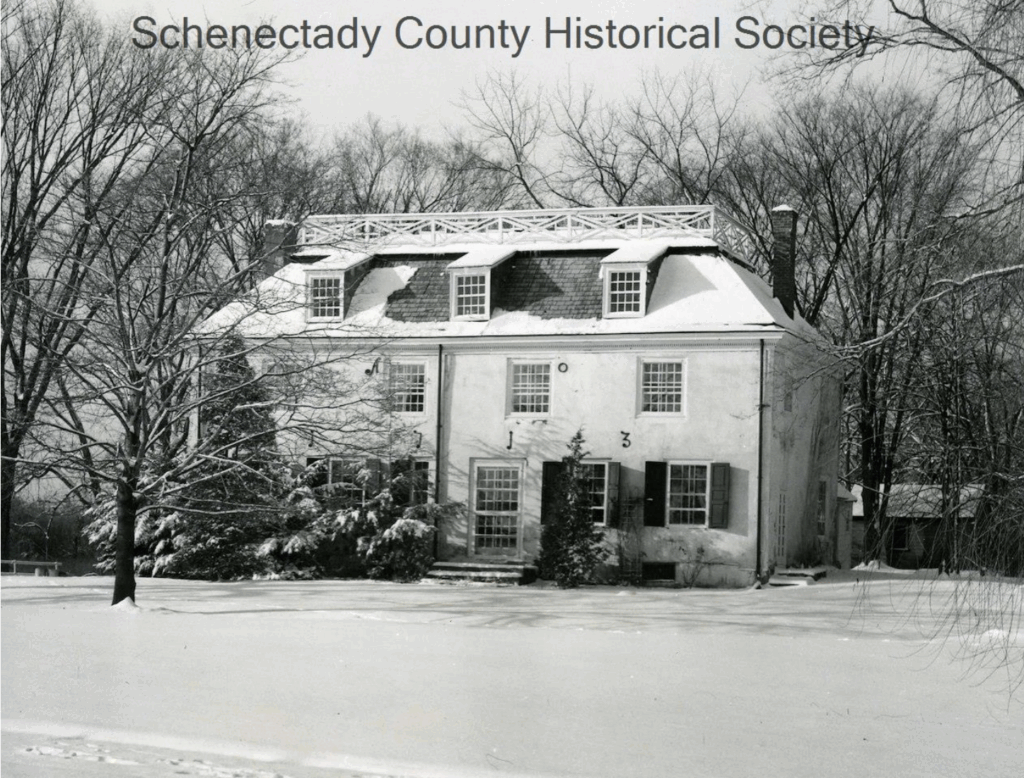
Cuyler Reynolds, whose research I generally trust, tries to put some clarity to a sometimes confusing genealogy.
He wrote that
“Alexander Lindsay, of the Glen, was born near Inverness, Scotland, about 1610. His family were adherents of the Stuarts, and it was probably for this cause that he left Scotland as a young man and went to Holland, where he entered the employ of the Dutch West India Company. In 1633, he was sent to America under the name of Sander Leendertszen Glen, Lindsay having been transformed into the Dutch patronymic of Leendertszen, or son of Leonard. When the English rule came in, he resumed his former name, but called himself Alexander Lindsay Glen, and by this second change, the surname of Glen became attached to his family and the Lindsay was dropped.”
However, another source says that Lindsay was his father’s name, and therefore it was the Dutch who attached that patronymic to him. Either way, it was Alexander Glen (let’s call him Glen) who named his estate Scotia, after his homeland. Alexander also built the “fine mansion” on the north bank of the Mohawk about 1658 or 1659 – by all reports, that house was on the flats and flooded frequently, and so the house was rebuilt, using many of the same materials, up on a bluff where some version of the house remains today. He died there in 1685. It was his son John (or Johannes) who was given the privilege of sparing many villagers from captivity in the 1690 massacre across the river in Schenectady (some accounts say it was his brother Sander).
Glen’s youngest son, John Alexander Glen (often styled by the Dutch as Johannes Sanderse Glen), built the eastern side of the house, the part with the prominent iron date of 1713. John’s son Jacob inherited the estate, and passed it on to his daughter Deborah. It was Deborah’s marriage to John Sanders of Albany that joined the family names, and thus the house became known as the Glen Sanders house – and it remained in the family until 1963.
A 1926 Gazette article says
” Without a doubt at all times the Glen-Sanders family was the owners [sic] of the largest tracts of land in Schenectady county, at one time this tract amounting to 2,000 acres and including the land on which the present village of Scotia is located. Today, unknown to most people in the city, there exists of the original farm a plot of 1,000 acres, or an area nearly as large as the present village of Scotia. This is undoubtedly the largest property in this vicinity, and, strange enough, for 250 years this land has not passed out of the ownership of the family of the original owners. Generation after generation of Glens and then Sanders have passed down the deeds to this land to their heirs until the tracts is [sic] owned by Mrs. Katherine Sanders Rose Galbraith, wife of Captain Galbraith, connected with the navy department at Washington. Mrs. Galbraith is the grand-daughter of the late Jacob G. Sanders, formerly of this city and a descendant of Johannes Sanders who married Deborah Glen in 1765.
Katherine, daughter of Jacob and Jane Sanders of Albany, was born in 1881 and died in 1964; she is buried in Arlington National Cemetery with her husband, Naval Captain William Galbraith.



Leave a Reply